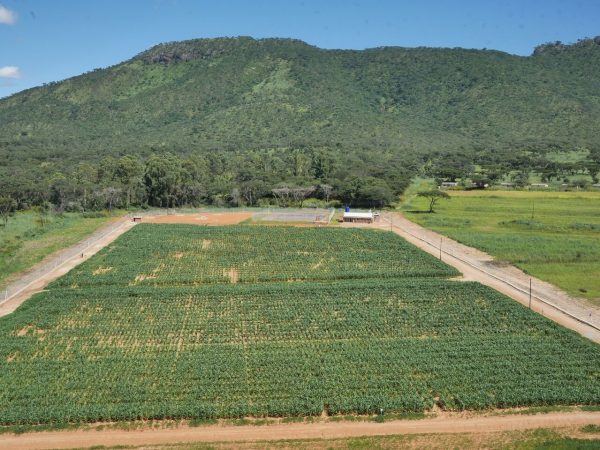
HARARE, Zimbabwe – The maize lethal necrosis (MLN) quarantine facility in southern Africa was officially opened in Zimbabwe on April 20, 2017 to enable safe introduction and exchange of novel maize germplasm from CIMMYT to partners in southern Africa.
Set up by the International Maize and Wheat Improvement Center (CIMMYT), with the approval of the government of Zimbabwe, the work for establishing the facility at the Plant Quarantine Station at Mazowe, outside Zimbabwe’s capital Harare, was initiated in the last quarter of 2015. The five hectare MLN quarantine facility funded by the United States Agency for International Development, is the first of its kind in southern Africa and will be used to safely import elite maize breeding materials from CIMMYT to southern Africa.
MLN is a devastating disease that causes huge economic losses if it occurs, particularly for smallholder farmers who frequently do not have means to control it. MLN was first detected in Kenya in 2011, and has since been reported in Democratic Republic of the Congo, Ethiopia, Rwanda, Tanzania, and Uganda. It is caused by a double infection of maize plants by two viruses: the maize chlorotic mottle virus and the sugarcane mosaic virus. Severe infestation can result in total yield loss. MLN-causing viruses are transmitted not only by insect vectors, but also by seed. There is an urgent need to prevent the deadly disease from moving further south.
The MLN quarantine facility is now functional. To date, over two hectares of land have been planted successfully with maize breeding materials imported from Kenya for the purpose of proactively breeding for MLN while at the same time preventing movement of the disease from endemic areas. Personnel have been trained to safely conduct activities at the site. The facility operates under strict quarantine regulations and is closely monitored and approved by Zimbabwe’s Plant Quarantine Services to ensure that the maize materials introduced are MLN-free.
“This modern quarantine facility is expected to uphold safety when importing maize breeding materials to southern Africa, and to facilitate local and regional institutions to proactively breed for resistance against the MLN disease,” said Zimbabwe’s Minister for Agriculture, Mechanization and Irrigation Development, Joseph Made, while officially opening the facility.
Dr Made also said “I am confident that the quarantine facility will play a significant role in curbing the spread of MLN, while at the same time facilitating on-going work of developing new maize varieties that are resistant to the disease.”
“This MLN quarantine facility, and the collaborative efforts between institutions of the government of Zimbabwe, especially the Department of Research and Specialist Services (DR&SS) and CIMMYT-Southern Africa Regional Office, are key to prevent the possible spread of MLN in southern Africa, and to develop and deploy elite maize varieties with MLN resistance and other farmer-preferred traits,” said B.M. Prasanna, Director of the CIMMYT Global Maize Program and CGIAR Research Program MAIZE, while speaking at the same occasion.

CIMMYT and the government of Zimbabwe have so far conducted two nation-wide MLN surveys. In the first, no incidence of MLN was recorded. Results of the second survey are still being assessed. To strengthen the phytosanitary work at this MLN quarantine facility, CIMMYT will also offer capacity building to DR&SS researchers through trainings, technical assistance, and advisory services.
MLN is a reality that cannot be ignored. Partners have to work together to control its spread through finding practical solutions to tackle this complex challenge, including strengthening MLN disease diagnostic and surveillance capacity. In addition, intensive inter-institutional efforts to develop and deploy improved maize varieties that incorporate MLN resistance should be continued. The commercial seed sector must also play a key role by producing and delivering MLN-free healthy seed to farmers.
Until seed companies in the MLN-endemic countries have produced 100 percent MLN-free, clean commercial seed, and have necessary certification from the national plant protection offices, the potential risk of MLN entering southern Africa and the consequent damage to maize producers from significantly outweighs the benefits of commercial seed trade.
MLN can only be effectively prevented and tackled through concerted inter-institutional and multi-disciplinary action. The key actions include: enforcement of synchronized maize plantings and a maize-free period of at least three to four months in a year in severely affected areas; creation of an extension corps specifically dedicated to creating awareness on MLN management among the farming communities and monitoring and implementation of standard operating procedures for production of MLN-free clean seed at various points along the seed value chain, to be used by all players in the seed industry.
CIMMYT developed and released, through national partners in eastern Africa, nine MLN-tolerant maize hybrids in the last three years. Four among these hybrids are already being seed scaled-up and commercialized by seed company partners in Uganda, Kenya and Tanzania. As many as 19 MLN-tolerant hybrids are under national performance trials in eastern Africa.
 Capacity development
Capacity development 
